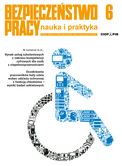Harnesses in personal equipment protecting against falls from a height
dr hab. inż. Krzysztof Baszczyński
An integral element of all personal fall protection systems, used both in industrial conditions and during sports and recreation, is the harness that the user of the equipment puts on. The most important tasks of the harness, depending on its type, include: supporting the human body during and after a fall arrest, enabling a supported position, supporting the user's body suspended during work with the rope access technique and preventing entry into the zone at risk of falling. The purpose of the harness is closely related to its construction. The article presents the basic structures and the materials used in them. The most important requirements for harnesses were presented and the rules for their selection depending on the conditions at the workplace, including the hazards and activities performed, were defined. The article also presents the basic principles of use, inspections and evaluation of the technical condition of the harness (with particular emphasis on the factors causing its degradation) and the conditions for its withdrawal from use. Based on the research conducted at CIOP-PIB, the problem of threats to humans in a suspended state in harness was presented.
DOI: 10.54215/BP.2022.02.3.Baszczynski
The type of employment and the mental well-being and involvement of employees – based on a literature review
dr hab. Dorota Żołnierczyk-Zreda
The article presents a review of the literature on research on the relationship between the type of employment contract and the well-being and productivity of employees, carried out in many European and non-European countries in recent decades. These results are inconclusive. Some of them indicate that employees employed under permanent contracts have a better mental well-being and are more productive at work than temporary employees, while others show the opposite relationship. One of the reasons for these discrepancies may be the different socio-economic context of the countries in which the research was carried out. In the context of the increasing probability of disappearance of permanent employment on the labour market in the world in general, we are a country which, due to the highest rates of temporary employment, can experience this process faster than other countries.
DOI: 10.54215/BP.2022.02.4.Zolnierczyk-Zreda
Diagnosis of the neurovascular form of vibration syndrome – review of testing methods
dr n. med. Elżbieta Łastowiecka-Moras
Prolonged exposure of humans to local vibration is associated with an increased risk of developing vascular, nervous, and musculoskeletal complaints. This syndrome is called vibration syndrome (vibration sickness). In practice, the disease is often diagnosed only at an advanced stage, when the worker's ability to work and perform daily activities is impaired. It is therefore extremely important that workers exposed to local vibrations undergo periodic examinations that increase the chances of early detection of the disease and, consequently, prevent the development of irreversible changes. The purpose of this article is to familiarize the reader with the testing methods applicable in the diagnosis of the neurovascular form of vibration syndrome.
DOI: 10.54215/BP.2022.02.5.Lastowiecka-Moras





























